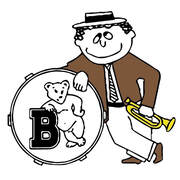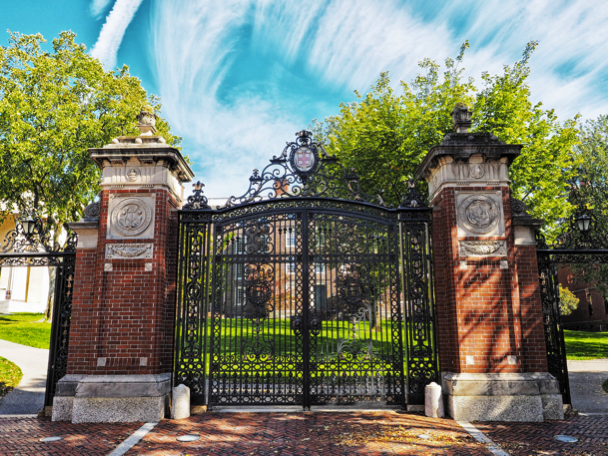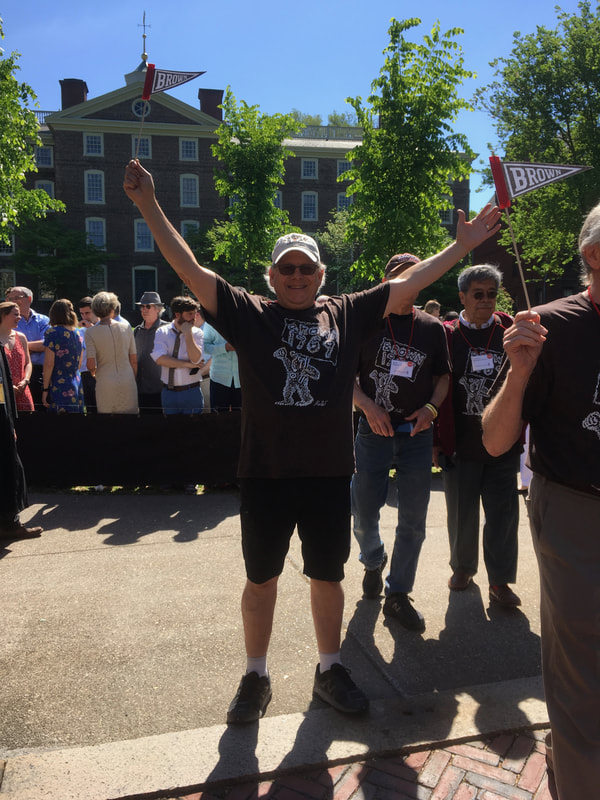This saga may have started on a fall day in 1928 when my dad, Sidney Ballon, first stepped on the Brown University campus as a freshman. Regardless, this has been a story long in the making. Dad and his younger brother, Herbie, the “Ballon boys” of Providence, were much heralded in their day. They took all the math and Latin awards at Classical High School, or so legend has it. They were both Phi Beta Kappa at Brown—Dad in the Class of 1932. The next generation benefited from their legacy. I don’t know about my brother, Jeff, five years my senior, but as for me, without legacy my high school grades alone surely would not have merited admittance to Brown. Yes, I had board scores showing a lot of promise, but face it, I neither knew how to study nor why one would bother. At the time, I was not ready for East Podunk Community College, let alone Brown. But I got in with the fervent hope that the small size of the school would provide a nurturing environment in which my potential would be realized. It didn’t. In addition to my having developed no discernible study skills, being practically devoid of intellectual curiosity, and possessing a prefrontal cortex very much “under development,” I also suspect that underlying that shaky intellectual foundation was even less stable psychological soil. I’ve come to believe that personal demons were at work, anxious to prove to me and to the world that I was unworthy. Simultaneously, they may have been striking back at my father for putting me in this untenable position. With all that at work, it’s a wonder it took me five semesters to flunk out! Chalk that up, I suppose, to perseverance. I had been skating on thin ice most of the way. During the fall semester of my junior year, I cleverly, if unconsciously, assured my academic demise and subsequent departure by scheduling a full slate of morning classes while virtually sleeping until noon every day. That allowed me to avoid the discomfort of sitting in a class for which I was unprepared. It also gave me a wide open afternoon and evening to pursue my real interests: intramural sports, marching band, writing scandalous halftime shows, playing bridge and hearts, and general horsing around with my buddies. (Okay, I did show up in the art studio by and large, but even there, my instructor questioned my commitment.) It’s only conjecture, fifty-one years later, but I have to assume I experienced as much relief as remorse when the hammer finally came down. And the guilt—yeah, there was a healthy dose of that. It was aided and abetted by Jeff, who had managed to squeak through with the Class of ‘64, and who may have taken a small measure of glee by bluntly declaring to me that I was “killing Dad.“ The fact is, by my dismissal, I got all that I had long, but unconsciously wished for—a ticket out. It was Jeff‘s fate (or choice) to follow in our father‘s footsteps—Brown, Hebrew Union College, ordination as a reform rabbi, service as a chaplain in the United States military, a pulpit in the south, a pulpit in the north. I, by contrast, could now cash in my golden ticket to do anything and everything else that life offered. What a relief! What a ride! The following autumn I miraculously found myself in a tiny art school in Portland, Oregon—yes, three thousand miles from Providence! It was the late sixties. Tune in, turn on, and drop out was the mantra. While I didn’t push that to its extremes, I, nonetheless, enjoyed a great burst of creativity and a refreshing breath of freedom. And yes, Jeffrey’s admonishment went with me wherever I went—mostly unconsciously, sometimes bursting through in judgment, shame, and anger toward myself and others. I have to accept my role in nurturing the shame throughout the years. Dad’s gone. Jeff’s gone. Of what use was it for me to perpetuate shame thrust on me for simply doing what I had to do? As the poet, Mary Oliver put it:
 There should be no villains in this story—just understanding, acceptance, and forgiveness. We all did all we could do, all we knew how to do, under circumstances not entirely of our making. At last, I’ve concluded that half a century is sufficient purgatory. To put it in another context, what do today’s youngsters do when they aren’t quite ready for college? They exercise the option of taking a “gap year”—not a socially acceptable approach, or one even given consideration back in the sixties. Aha! How clever of me! Ahead of my time! I unwittingly created my own “gap year”—albeit two-and-a half years, albeit at great expense, albeit nonsensically on a college campus instead of a worthy alternative. And what did I accomplish in the “intersession“ of my own making? I met a lot of unmet needs that were critical to my development and to preparing me for a life of learning—just as a gap year should. Perhaps the greatest need that was met at Brown, in sharp contrast to my life at West Hempstead High School, was a sense of social ease. In high school I was known to one and all as “the rabbi’s son” and suffered from more than the typical adolescent alienation. Whereas, at Brown, no one knew or cared who my father was. I was one of the guys! I had buddies. We played cards and sports, watched the original Mission Impossible and Batman, had meals together in the refectory, hung out in the dorm. I fit in! One rewarding similarity with high school was how I took a leadership position in the band. At Brown, due to the nature of the largely student run organization I had an even greater role than in West Hempstead. It wasn’t long before I became part of the comedy writing team responsible for the aforementioned scandalous halftime shows. Later, when I became president of the band, I used my art skills to create a cartoon self-portrait as a “mascot” logo that, much to my surprise was, in later years, dubbed Elrod Snidley, and is still in use today—my legacy to Brown! (3) Meanwhile, my frontal cortex was slowly developing, such that academic pursuits subsequent to Brown were highly successful—an artistic achievement award from the University of Judaism, dean’s list and a bachelor’s degree in education from Hofstra, a Master of Architecture from Yale, to wit. Yes, Brown provided a virtual and formidable “gap year.“ I am proud of my achievements there and all that they led to throughout my academic and professional life. I didn’t come to this realization in a single flash of insight and clarity. It was a process. It took some time, some deep probing, some work. Strange as it may seem, I owe a lot to my dreams—not the aspirational kind, but the one’s that come in the middle of the night. I’ve long paid attention to them, and especially so in the last few years. I have a friend with whom I regularly meet to support each other in sifting for the subconscious messages to be found in our dreams. I have a spiritual director who has expertise in doing dream work in a spiritual context. And I have worked with a Jungian therapist for whom my dreams provide fertile ground for psychological exploration. I can’t say exactly when and where among these resources I finally put all the pieces together. That’s part of the magic of living an “examined life.” In his book, From Age-ing to Sage-ing, Rabbi Zalman Schachter-Shalomi says that part of a constructive approach to aging is to make amends with the past by recontextualizing one’s life. Having finally reframed the joys and sorrows of my Brown experience, there was only one thing left for me to do. For the reader to appreciate this next point, I must describe a piece of Brown University lore. Brown’s Van Wickle Gates provide a ceremonial entrance to the campus. The monumental main gates are flanked by two smaller side gates that remain open throughout the year. The central gates, however, remain locked except for the first day of each semester when they open inward for incoming students and on Commencement Day each May, when they swing outward for the graduation procession. The Van Wickle Gates, Brown University (4) On the first day of classes in September 1965, I walked alone through the grand inward swinging gates, and vowed that I would exit four years hence with the Class of ’69. However, having taken leave of the campus in February 1968, that was a box that remained unchecked all these decades. It was with full appreciation of the traditions associated with the gates, as well as my arduous wrestling with the demons of the past, that I chose this year to take my place with the Brown University Class of 1969 and pass through the Van Wickle Gates to commemorate the 50th reunion of our class and my first return to campus, now as a proud alum.(5) ---///--- I did it! It was stupendous! Memorial Day weekend was devoted to class reunions and Commencement exercises at Brown. Friday and Saturday provided much joy as I reunited with guys (and a very few gals) who were part of my life at Brown. I’m a bit of a reunion junkie of late. With my high school 50th and architecture school 40th reunions in recent years, I’ve come to deeply appreciate the perspective on life that such gatherings afford. This was no exception. There was ample time to socialize with old buddies, as well as with folks whose names and faces I never really knew well and, in many cases, not at all. There were thought-provoking programs allowing us to examine such topics as the revolutionary curriculum reform instituted just after I left (such the pity), the Black Student Walkout of 1968 demanding true inclusion of minorities, as well as the impact of the Vietnam War on class members whether we were gung-ho ROTC trainees, strident war protesters, or anywhere in between. One highlight was a visit I made to the current Brown University Marching Band as they rehearsed for Sunday’s commencement festivities. It is their tradition to listen to firsthand accounts of the band’s history from returning band alumni. I gladly joined my two closest friends from our days in the band to share some memories. Not only did I give them the backstory of the creation of Elrod Snidley, but I also, spontaneously, took the opportunity to pass on some hard-earned advice, suggesting that they not take things overly seriously when they are faced with challenges—I consider myself living proof that things change! ---///--- All along, it was really about Sunday morning and the commencement processional. The way it is customarily choreographed is for the band to lead the graduating class through the gates, followed by the faculty and the alumni, by year, beginning with the oldest. Each group proceeds down the street with individuals peeling off to one side or the other as they go, creating an ever-lengthening corridor of admirers cheering the succeeding marchers. That’s great fun in itself. It becomes a long, long line of revelers on each side of the street that stretches out of sight down College Hill. As the few classes ahead of ours made their way through the gates, my sense of anticipation grew. Finally, I arrived at the mythic threshold to the campus. My two band buddies, seasoned veterans of this annual event, had intentionally moved ahead of me, all the better to capture “my moment” on their iPhones. I am so glad they did, given that their photos and videos convey what I can barely put into words. The scene was pretty much a ragtag bunch of gray-hairs waving tiny Brown pennants. Many classmates were clad in brown commemorative t-shirts designed for our class by famed New Yorker cartoonist and Brown art professor emeritus, Ed Koren. The steady cadence of a bass drum punctuated the whoops of the crowd. Suddenly I appear amidst the crowd, walking noticeably slower than those around me. Clearly I want to savor this moment. With pennant raised high in my right hand, I pause for a photo op and raise my left hand just as high—two outstretched arms capturing the expansive energy of the moment. Fellow classmates, oblivious to the ritual I am living, continue streaming past me as I am holding the moment in time and space as long as I can, finally taking two steps that complete my passage beneath the iron arch. As I stride, I bend my neck backward, looking up, bringing my hands to my mouth, blowing a kiss to the gates or to the heavens, uttering an audible sigh of contentment. My slow steps turning into a saunter as the grin on my face widens even further. The last group in the procession—the most recent alumni—passed through the gates. Then, in order, the previous marchers left their positions along the side of the street cascading through the throng below them like a sock folding inside out, allowing every participant to pass by every other participant. Our class, being among the eldest alumni, was one of the earliest groups to march down, so in this second phase we passed by many more on the sidelines than we had at first. It seemed that spirits were continuously rising. Given that our class was well established in Brown history as being responsible for the radical curriculum change that has made Brown one of the most desirable institutions of learning, and perhaps with some prurient chortling at the Class of Soixante-neuf thrown in, there were great cheers for us as we walked down the hill. The pace seemed to quicken as I strode along slapping countless high-fives, spontaneously bestowing blessings of peace, love, happiness, prosperity, satisfaction, upon every eager hand and face among those in cap and gown. It was the closest experience I’ve had to emulating the loving bestowal of blessing I saw my brother so freely give in his final days. It answered the question I have often asked since, “Is it possible to spread love and blessing without having a fatal diagnosis?“ Indeed it is. Granted, this was a unique set of circumstances. Nonetheless, it was pure joy. ---///--- At last, I had taken my triumphal march through the Van Wickle Gates! The vow I had made as an entering freshman so many years ago, only needed a little modification to become realized. What I eventually accomplished—without respect to the timing—was to march through these storied gates with my classmates as an educated man. What more could I ask for? Ironically, I was not the only member of the Class of ’69 who received this delayed gratification that morning. As it so happened, none of my classmates walked through the gates in 1969. The political unrest was such back then, that the administration was afraid that our activist class would stage a disruptive and embarrassing protest. Thus, they used the flimsy excuse of mildly inclement weather to move graduation indoors to the hockey arena that year. The Van Wickle Gates have acquired numerous legends and superstitions over the years. The Brown Alumni website acknowledges the history and mystery of the gates on a page devoted to them. They close their posting, as shall I, with this piece of insight based on the etymology of the word gate:
I couldn’t agree more.
0 Comments
Your comment will be posted after it is approved.
Leave a Reply. |
AuthorFor access to 77 postings on my previous Yesh Indeed blogspot.com site CLICK HERE. Archives
December 2021
Categories |


 RSS Feed
RSS Feed
